
The name 'Billys and Charleys' was given to a type of archaeological forgery from the 1850s. The following article, which appeared in the Hampshire magazine in May 1993, concerned some such artefacts discovered at Wymering Manor in 1946. It was written by Peter Rogers to whom we offer thanks for permission to reprint and to publish the images of the artefacts below.
AN EXERCISE IN DETECTION by PETER N. ROGERS
WYMERING Manor, recorded in the Domesday Survey of 1086, probably had as its centre a Manor house which was the predecessor of the building which we know today. The present house, although dating only from the 16th century, contains within it's fabric materials from both the Roman and Mediaeval periods.
The site is certainly Saxon and may well be Roman in origin, a Roman coin and spoon being recently discovered within the grounds.
Many and varied are the tales of mystery connected with the old Manor House. Stories of ghosts, secret passages, priest holes and a concealed room have been told and re-told over many years and yet, possibly the most intriguing and mystifying narrative of all has never before been placed on record; it remains today an enigma which has never ceased to baffle.
Many owner-occupiers have resided in the house; however, for our story we must, for reasons which will become apparent, consider only those who dwelt there after 1858 and, for the moment at least, accept 1946 as the commencement of our mystery. It was in 1946, following the wartime military occupation of the property, that the new owner, Mr. Leo Metcalfe Snr. set about restoring the house to something approaching its pre-war condition. It was during this work that a discovery was made beneath the floor of the drawing room of 21 lead figures, each of a religious nature, three to seven inches in size and of a type known as mediaeval pilgrims' badges or tokens.
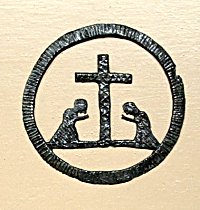
The excitement generated in the newspapers of the day suggested that they could be as much as 1,000 years old, although subsequent examination at the Portsmouth City Museum and, perhaps more importantly, The British Museum's department of Mediaeval Antiquities, placed them in the class of 19th century `Shadwell Docks Forgeries'.
It is now necessary to the plot to turn to the London of the 1850s and '60s and to events which caused a shock wave among antique dealers and collectors. Events, it will be noted, which also reached the provinces and could have been directly or indirectly responsible for the Wymering discoveries of 1946.
Pilgrims' badges (tokens of devotion purchased at the shrines of the Saints) are, most often, crudely fashioned figures of saints, bishops, angels, crusading knights etc. Antique collectors have always prized such items and, when they are occasionally discovered, will readily purchase them.
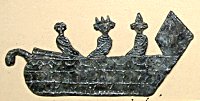
It was during the digging of London's Shadwell Docks in the 1850s that a great number of these tokens were purported to have been unearthed by two labourers (Shore-rakers or Mudlarks) William Smith and Charles Eaton (Billy and Charley). The tokens were, in fact, forgeries manufactured by this illiterate but ingenious couple who were so successful in their subsequent sale that it was not long before they expanded their business, becoming more ambitious in the scope of their output, producing ampullae, reliquaries and small statuettes.
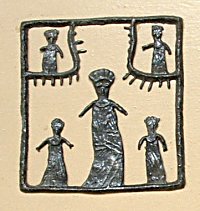
These and other examples were said to have been discovered at almost every site in London which involved the digging of sewers, docks and railways! Many were stated to have been excavated at Queenhithe. One dealer was so impressed that he bought large quantities for several hundred pounds, later bringing a libel action against the Athenaeum Magazine when they were condemned as forgeries. Other forgers recognising the cash potential also began to manufacture and, as a consequence the nation became flooded with counterfeit items, not necessarily confined to Pilgrims' tokens.
Whether or not produced from the moulds of William Smith and Charles Eaton, all such fakes of doubtful origin have since been labelled 'Billys and Charleys', perhaps giving the pair a certain amount of undeserved notoriety. Guilty as they obviously were, they were never prosecuted, for it would have been difficult to prove that they had actually broken the law!

Returning to the Wymering finds, a statement from the British Museum in 1947 declared that 'The Wymering Billys and Charleys are in the style of the Shadwell Dock forgeries rather than actual Shadwell Dock productions', it being further suggested 'that they were probably manufactured local to Wymering, perhaps as a cottage industry.'
The question must now be posed — who produced the Wymering tokens? For what reason, and why was it necessary to secrete them beneath the floor of the house?
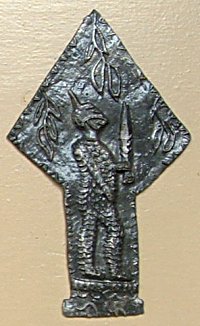
Taking each of the occupiers in turn, let us examine them for integrity and/or of their need to be involved in such dubious. practices.
In December, 1858, the Reverend George Nugee became (following the death of his younger brother Andrew) Vicar of Wymering. He apparently purchased the Manor House choosing to reside there in the company of 12 young men belonging to his recently re-created Order of St. Augustine. The nearby vicarage was set aside as accommodation and base for his Sisterhood of St. Mary which had accompanied him from his previous appointment in London.
The Rev. Nugee was a colourful personality of independent means, having a distinct propensity towards particularly high church services and ritual. During his incumbency at Wymering, he built a private chapel in the Manor House and, in addition, what is apparently an oratory concealed within the walls of an upstairs room. In 1872 after appearing before a Royal Commission on Church Ritual and later enquiries into his questionable morality, he was ordered to resign his living and leave the parish. He died at Talaton, Devon, in 1892.
George Peel, a local farmer, purchased the Manor House and grounds in 1872 though continued to live at Wymering Farm, leasing the Manor to Richard William Ford (who later became Mayor of Portsmouth). Mr. Ford died in 1900 and is buried at Wymering Church. George Peel then sold the property to Anna Maria Martin Nightingale and her nephew Thomas Knowlys Parr who moved to Wymering following the sale of property in Lancashire. Anna Nightingale predeceased Thomas Parr, who himself died in 1938. Parr became a benevolent local 'squire' who during his years at Wymering did much good for the local community.
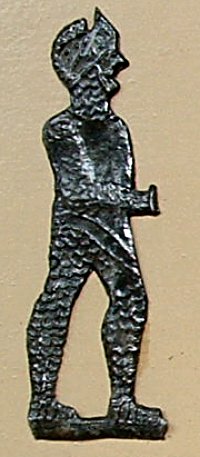
Negotiations by Mr. Leo Metcalfe to buy the house in 1939 were aborted when hostilities became a possibility and properties such as the Manor were being requisitioned by the military. Various units were quartered in the house and grounds for the duration of the war. With the coming of peace and the house being released by the services, the interrupted negotiations to purchase were resumed with Mr. Leo Metcalfe becoming the new owner. Readers will recall that it was during his renovations that the tokens were discovered.
In 1959, the house again changed hands and was purchased by the City of Portsmouth; now a listed building, it is leased to the Youth Hostels Association.
In an attempt to prove or disprove that the tokens were manufactured in the house or grounds a thorough search has recently been carried out using a metal detector and, although no evidence has been unearthed of token figures, many random finds have been made in the form of 'swarf' and lead boilings, that is, the rubbish which collects in the crucible when smelting. It was during these searches that the Roman items were discovered. Investigations continue, and here acknowledgement must be given to Mr. Leo Metcalfe Jnr. for information and help, and to both he and Mr. John Stedman of the Portsmouth City Museums for making available for examination, the Wymering tokens.
To Mr. Robert Halliday, who is probably the foremost authority on mediaeval and antique Pilgrim Tokens and forgeries in this country, sincere thanks are offered for professional advice and allowing free access to his research papers. Robert Halliday also produced evidence of another possible local link in the Billys and Charleys story. It concerns the Reverend Edmund Kell who, in 1868, forwarded for exhibition, 'Some spurious antiquities which had been purchased by an acquaintance of his at Portsea, with a request for information as to their manufacture.'
One question poses another and here we must ask, who was the Reverend Kell? Did he have knowledge of or a connection with Wymering or the Reverend Nugee? Research through the registers of Church of England clergy failed to reveal Edmund Kell until quite by chance, he was discovered to be a Unitarian Minister, firstly at Newport, Isle of Wight and later at Southampton, where his name is perpetuated in the name of the Kell Hall. In the circumstances, considering the differing religious paths they had chosen in life, it is quite unlikely that they would have known each other, although 'an acquaintance at Portsea' would fit into the scheme of things very well. The Reverend Kell, following his death in 1874, merited a lengthy and particularly complimentary obituary in the Journal of the British Archaeological Association of which he was an associate.
Whoever designed and created Wymering's Billys and Charleys obviously possessed an unusually accurate and probably professional knowledge of early church regalia and accoutrements for, while the castings were quite crude, the detail is both intricate and precise.
Unlike the many other mysteries and unexplained stories of Wymering, the evidence of the Billys and Charleys still remains and the clues are tangible even today. They are currently housed in the Portsmouth City Museum on loan from Mr. Leo Metcalfe Jnr.
Postscript
The artefacts are no longer at the Museum having been returned to Mr Metcalfe some years ago. Billys and Charleys are now highly sought after items, often selling at between £50 and £100 at auction.
The full article by Robert Halliday